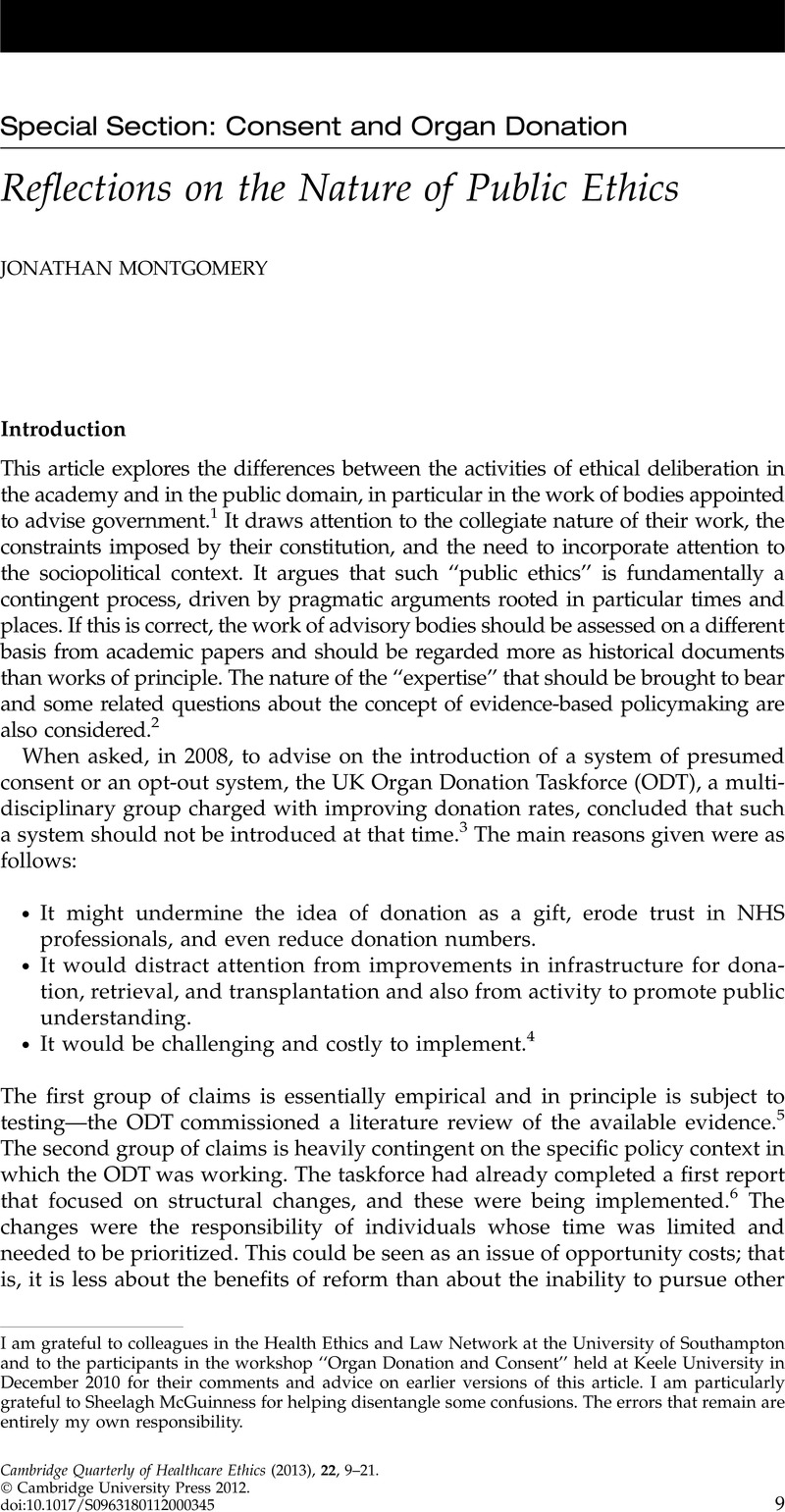Published online by Cambridge University Press: 04 December 2012

1. The article draws on the author’s experience of sitting on the Organ Donation Taskforce, the working party of the Nuffield Council on Bioethics (an independent UK body that produces reports on ethical issues in biology and medicine) that produced its report entitled Public Health: Ethical Issues, and the UK health departments’ Committee on Ethical Aspects of Pandemic Influenza, and of chairing the Human Genetics Commission. It sets out a personal perspective on the nature of the work of such bodies and does not represent the views of those groups, nor the bodies that sponsored them.
2. This article considers briefly the role of scientific expertise; for analysis of expertise in moral philosophy and its proper contribution, see Archard, D. Why moral philosophers are not and should not be moral experts. Bioethics 2011;25(3):119–27.CrossRefGoogle Scholar
3. Organ Donation Taskforce (ODT). The potential impact of an opt-out system for organ donation in the UK. An independent report from the Organ Donation Taskforce. London: Department of Health; 2008. For the relevant documents, see http://www.dh.gov.uk/en/Publicationsandstatistics/Publications/PublicationsPolicyAndGuidance/DH_090312 (last accessed 7 Sep 2012).
4. See note 3, ODT 2008, 35.
5. See note 3, ODT 2008, annex I.
6. See note 3, ODT 2008.
7. For the report on this engagement, see note 3, ODT 2008, annex J. For other stakeholder correspondence, see annexes K and L.
8. See note 3, ODT 2008, annex D.
9. Hansard HC. 17 Nov 2008, vol. 483, col. 5WS.
10. Dirty hands . . . the human cost: 2006 annual report of the chief medical officer on the state of public health. London: Department of Health; 2007, at chap. 4.
11. Sometimes minutes are available that enable this process to be traced, for example, see the Committee on Ethical Aspects of Pandemic Influenza minutes, archived at http://webarchive.nationalarchives.gov.uk/+/www.dh.gov.uk/en/Publichealth/Flu/PandemicFlu/DH_065163 (last accessed 7 Sep 2012).
12. Report of the Committee of Inquiry into Human Fertilisation and Embryology. London: HMSO; 1984, at Cmnd 9314, para 11.22. This recommendation was subsequently accepted by Parliament on a vote on alternative versions of cl 11 of the bill, which became the Human Fertilisation and Embryology Act 1990.
13. Smeaton v. Secretary of State for Health [2002] EWHC 610 (Admin).
14. For an account of these issues, see Warnock, M. Nature and Mortality: Recollections of a Philosopher in Public Life. London: Continuum; 2003Google Scholar, at 94–101.
15. The tensions that arise from indeterminacy in this field can be seen to be played out in the debates over the need for precision in prosecution policy around assisted suicide following the decision of the House of Lords in R (Purdy) v. DPP [2009] UKHL 45, see further Montgomery, J. Guarding the gates of St Peter: Life, death and law making. Legal Studies 2011;31(4): 644–66.CrossRefGoogle Scholar
16. See note 14, Warnock 2003, at 99–100.
17. For example, Beauchamp, T, Childress, J. Principles of Biomedical Ethics. 6th ed.New York: Oxford University Press; 2008.Google Scholar
18. Nuffield Council on Bioethics (NCB). Public health: Ethical issues. London: Nuffield Council on Bioethics; 2007. This was the report of a working party chaired by Lord Krebs, of which the author was a member.
19. See also Montgomery, J. The legitimacy of medical law. In: Maclean , S, ed. First Do No Harm: Law Ethics and Medicine. Aldershot: Ashgate; 2006Google Scholar, at 1–16.
20. Coggon, J. Harmful rights-doing? The perceived problem of liberal paradigms and public health. Journal of Medical Ethics 2008;34:798–801CrossRefGoogle ScholarPubMed, exploring Raz, J. Ethics in the Public Domain. Oxford: Clarendon; 1994.Google Scholar
21. Mill, JS. On Liberty. London: JM Dent; 1972 (originally 1859)Google Scholar.
22. See, for example, Dawson, AJ, Verweij, M. The steward of the Millian state. Public Health Ethics 2008;1(3):1–3.CrossRefGoogle Scholar
23. World Health Organization. World Health Report 2000. Geneva: WHO; 2000.
24. Jochelson, K. Nanny or Steward? The Role of Government in Public Health. London: King’s Fund; 2005.Google Scholar
25. Brown, G. Organ donations help us make a difference. The Sunday Telegraph 2008Google Scholar Jan 13.
26. Warner G. Gordon Brown wants to nationalise our bodies by enforced organ donation; available at http://blogs.telegraph.co.uk/news/geraldwarner/5721489/Gordon_Brown_wants_to_nationalise_our_bodies_by_enforced_organ_donation (last accessed 11 Feb 2012).
27. Marrin, M. Even in death our organs are not for the PM to snatch. Sunday Times 2008Google Scholar Nov 16.
28. See note 18, NCB 2007, para. 4.33–4.35.
29. For more explicit discussion of this point, see note 18, NCB 2007, para. 3.3–3.12.
30. See note 18, NCB 2007, para. 4.13.
31. See note 18, NCB 2007, chap. 7.
32. The working party drew principally on McDonagh, M, Whiting, P, Bradley, M, Cooper, J, Chestnutt, I, et al. . A Systematic Review of Public Water Fluoridation. York: NHS Centre for Reviews and Dissemination; 2000Google Scholar.
33. R (Milner) v. South Central SHA [2011] EWHC 218 (Admin). It should be noted that the author chairs NHS Hampshire, which supported the fluoridation scheme, although the formal responsibilities for assessing the views expressed by the public lay with the Strategic Health Authority, NHS South Central.
34. Water Industry Act 1991, s 87; Water Fluoridation (Consultation) (England) Regulations 2005, SI 2005 No. 921.
35. See note 33, R (Milner) v. South Carolina SHA [2011].
36. This engagement led to very rich data, and the quantitative material discussed here is only a small part of it—see note 3, ODT 2008, annex J.
37. See note 3, ODT 2008, fig. 2 on p. 26.
38. See note 3, ODT 2008, para. 12.5 and 12.9.
39. http://www.dignityindying.org.uk/research/opinion.html (last accessed 7 Sep 2012), citing McAndrew, S. Religious faith and contemporary attitudes. In: A, Park, Curtice, J, Thomson, K, Phillips, M, Clery, E, Butt, S, eds. British Social Attitudes: 2009–2010. The 26th Report. London: Sage; 2010Google Scholar, at 87–113.
40. http://www.carenotkilling.org.uk/?show=441 (last accessed 7 Sep 2012).
41. See note 2, Archard 2011.
42. See note 3, ODT 2008, para. 6.8.
43. See note 3, ODT 2008, para. 11.1–11.5.
44. See note 3, ODT 2008, annex I.